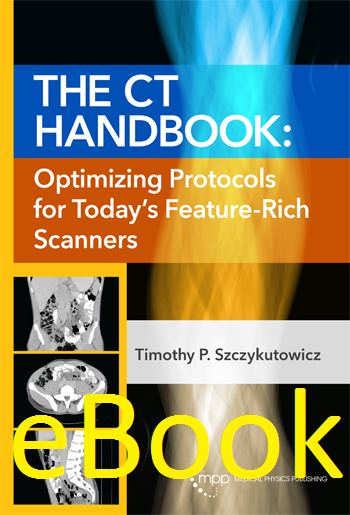
The CT Handbook: Optimizing Protocols for Today's Feature-Rich Scanners
Author: Timothy P. SzczykutowiczISBN: 9780944838570
Published: May 2020 | 580 pp | eBook
Price: $ 165.00
EFOMP | European Medical Physics News | Ιssue 01/2021 | Spring
The subtitle of this book indicates already its main intention: to provide the necessary background for the practical understanding and optimizing of the use of CTs in the clinic. In this context, the term “protocol” in the subtitle has a broader meaning including the whole workflow of the patient CT-scan from patient positioning (this is given a chapter of its own!), contrast agent and injector handling as well as the technical factors influencing the dose and the image quality of CT-scans. On top, it includes also hints for optimizing the expensive time of a service technician or application specialist upon installation of new protocols or tips on how to select networking options to other dedicated workstations, too.
Among the 17 chapters of this 580- page book are the usual basic ones on CT history, reconstruction techniques, image quality and CT-dose parameters providing all the necessary background for understanding the practical protocol optimization that is discussed in following chapters. For deeper scientific information on the theory and special reconstruction techniques of CT, the author refers to already existing well-known publications by Buzug, Hsieh, Kak, Kalender or published reviews in journals. Only a reference to the recent book by Samei and Pelc is missing, maybe because it was also published in 2020. A note to teachers: Each chapter has its list of well-selected references at the end which makes it a well-suited material for teaching purposes having students work on the topic of the chapter as a project. Nevertheless, this book is not a simple collection of lumped together chapters, since the author guides the reader very well through his book by giving references to other sections or chapters. While the main emphasis of the book is on medical diagnostic CT, there is also a chapter on CBCT e.g. in radiotherapy and the use of non-diagnostic CT in science and industry, as shown in Figure 1 where a CT-scan is used for non-destructively separating rock from bone of a mineralized dinosaur skull.
A very valuable feature of this book to clinical medical physicists is that the author addresses the differences in CTs of the main vendors (GE, Canon/Toshiba, Philips, Siemens) not only for special features like dual-energy but also for more basic differences in their automatic exposure control (AEC) algorithms. Another “red line” followed throughout the book is that valuable guidelines and checklists are given not only for configuring protocols of already existing CTs but also for selecting an efficient set of its features when a new CT is to be ordered for the clinic or department.
It is quite noticeable that the author addresses not only medical physicists, but also explicitly radiologists and radiographers/technologists with special remarks from time to time. The “CT protocol team” consisting of these professions is an important feature in designing and optimizing the CT protocols based on the “master protocol concept” introduced by the author. This is a result of his long practical experience in CT and in its pitfalls that are very well summarized in this book. An explicit example is an extensive chapter (72 pages) on artefacts. As an additional feature, there is a table of the figures of artefacts that are shown in this book in the appendix, where they are categorized by different characteristics for identifying the cause of the artefact. While the book, in general, is very well illustrated with images and coloured figures, many CT images are reproduced rather small in “thumb-size anatomy”, at least in the printed book. Strong artefacts are still visible in these images, but others can only be recognized with the help of arrows added. Again a note as a lecturer: This nice collection of CT artefacts would be a good source for practical teaching if the images could be provided in electronic format as a separate added value – best as anonymized DICOM files such that students need to find out the proper window settings themselves. Another suggestion for the next edition of this wonderful book would be to add a list of abbreviations and acronyms since not all are spelt out upon first use and international readers or students new to this subject might not be familiar with these English acronyms. An index of the book could be helpful for readers at least of the printed version, too.
Finally, this excellent CT-handbook is a must-have for all those who are or going to be in charge of optimizing the workflow and protocols of the modern “workhorse CT” of today’s radiology department and who want to have it at hand in one volume!
Reviewed by: Prof. Dr. Markus Buchgeister, Beuth Hochschule für Technik, Berlin, Germany


